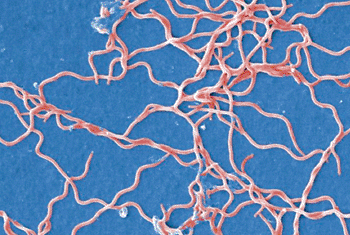Advanced Technique Diagnoses Lyme Disease Early
By LabMedica International staff writers
Posted on 06 May 2013
Patients who contract Lyme disease need a quick diagnosis so that essential treatment can begin to avoid long-term complications.Posted on 06 May 2013
The diagnostic process may be delayed if a physician does not recognize a skin rash caused by Lyme disease because it does not have the bull's-eye appearance that is best known to physicians and the public.

Image: Scanning electron micrograph of Borrelia burgdorferi (Photo courtesy of Janice Haney Carr).
Scientists at University of Medicine and Dentistry of New Jersey (UMDNJ; Newark, NJ, USA) working with others, enrolled 14 patients in an ongoing prospective trial which includes an advanced diagnostic technique that employs a selective amplification of DNA from Borrelia burgdorferi, the spirochete that causes Lyme disease. This technique uses electrospray ionization mass spectrometry and isothermal amplification. This is then followed by polymerase chain reaction (PCR) testing, all designed to detect even small numbers of multiple strains of the Lyme agent. The patients were all over 18 years of age and lived in suburban Baltimore (MD, USA), where Lyme disease is endemic.
Unlike existing methods used to diagnose Lyme disease, the novel experimental technique is able to detect evidence of B. burgdorferi early, even in cases where the bacterium is still at low levels in the bloodstream, and sooner than traditional antibody tests, which may require several weeks before becoming positive. It also is able to distinguish between new infections and prior exposure to B burgdorferi.
Of the patients analyzed, ten were identified by the experimental technique to have strong microbiologic evidence of Lyme disease although they had presented with skin lesions that differed markedly from the classic bull's-eye pattern. The authors noted that “This emphasis on target-like lesions may have inadvertently contributed to an under appreciation for atypical skin lesions caused by Lyme disease." PCR of skin biopsy samples may provide insight as to whether a negative blood PCR is the result of infection with a skin-restricted strain in patients in whom bacterial dissemination is not expected or a result of low copy number of B. burgdorferi in the blood sample.
Steven E, Schutzer, MD, the senior author of the study, said, “Doctors who see a rash in a patient who has been in an area where Lyme disease frequently occurs should be alert to the fact that the Lyme disease rash does not have to look like a bull's-eye, ring-within-a ring, known as erythema migrans. The rash may look different. Doctors should search carefully both for other signs that might suggest Lyme disease, such as flu-like symptoms, and equally for signs that may point towards other conditions. Early diagnosis of most diseases gives the best chance for a cure. This is especially true for Lyme disease." The report was published in the May 2013 issue of the journal Emerging Infectious Diseases.
Related Links:
University of Medicine and Dentistry of New Jersey













